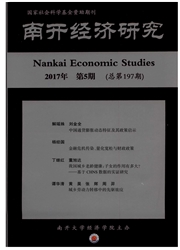

 中文摘要:
中文摘要:
本文通过构建一个空间动态博弈模型,考察了集聚视角下领先企业与跟随企业间的多维技术溢出效应对双方企业创新动力的影响,发现在单向溢出效应和双向溢出效应不同情形下,对企业创新动力的激励有着根本不同的表现。由此引申到对我国地方产业集群的两种基本形态——“小企业群生型”和“主企业领导型”企业网络模式的不同创新绩效及产业升级动力模式差异的解释。指出,主企业领导型的集群分工模式对于改变我国地方产业集群内,普遍模仿和跟随行为盛行所导致的“集体创新动力缺失”困境以及产业升级动力不足,可能具有内生推动机制与中国现实制度环境约束条件下的重大作用。
 英文摘要:
英文摘要:
Through constructing a dynamic gamble model, the paper examines that different technologic spillover between leading enterprise and following one, which existed in agglomeration statue. In this paper, we find that horizontal spillover and vertical spillover have different influence on enterprises' innovation behavior. Utilizing these theoretical resuhs, we analysis the difference to innovation ability and industrial upgrading path between small enterprise agglomeration LICs and core enterprise leading LICs. Finally, we point to this view that establishing core enterprise leading LICs with self-innovating and self-improving ability is a way out to "collective innovation dynamic deficiency" upgrading dilemma in China LILs at the background of economy and institution transferring.
 同期刊论文项目
同期刊论文项目
 同项目期刊论文
同项目期刊论文
 期刊信息
期刊信息
